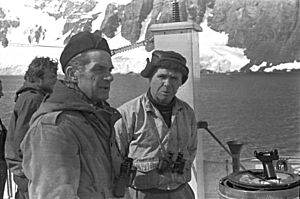Edward W. Bingham facts for kids
Quick facts for kids
Edward W. Bingham
|
|
|---|---|

Edward Bingham (on the right), FIDS commander, in the Antarctic Dec 1945
|
|
| Born | 2 January 1901 Dungannon, County Tyrone, Ireland, UK |
| Died | 1 September 1993 (aged 92) Halstock, Dorset, England, UK |
| Allegiance | |
| Service/ |
|
| Years of service | 1928 - 1957 |
| Rank | Surgeon Captain |
| Battles/wars | World War II |
| Awards | Polar Medal Order of the British Empire |
Edward W. Bingham was a brave British Royal Navy officer and a famous polar explorer. He was a doctor who traveled to the coldest parts of the world. He earned a special award called the Polar Medal, and it was so rare that he received it with three clasps! This showed how many amazing journeys he made to the Arctic and Antarctic.
Contents
Edward Bingham's Early Life and Adventures
Edward William Bingham, also known as Ted, was born on January 2, 1901. His hometown was Dungannon in Ireland. His father was a headmaster at a school there. Edward studied medicine at Trinity College, Dublin, and became a doctor in 1926.
In 1928, Edward Bingham joined the Royal Navy. This was the start of his exciting career. Just two years later, he volunteered for a special trip.
Exploring Greenland's Ice
In 1930, Bingham joined the British Arctic Air Route Expedition. This team explored the east coast of Greenland. His main jobs were to be the expedition's doctor and to look after the sled dogs. He helped set up a weather station on the huge ice cap. He also went on a three-month journey to map the edge of the Greenland Ice Sheet. He even tried to climb Mont Forel, which is the highest mountain in that area!
Working in Labrador
After his Greenland adventure, Bingham worked on a ship called HMS Challenger. For two years, he helped map the coast of the Labrador Peninsula in Canada. He spent a winter there and became even better at working with huskies and driving dog teams. This experience was very important for his future trips.
Journey to Antarctica
From 1934 to 1937, Edward Bingham went to Antarctica. He was part of the British Graham Land Expedition. Again, he was the medical officer and in charge of the dog sled teams. He took part in a huge 535-mile trip across Graham Land. This journey helped prove that Graham Land was part of a larger peninsula, not a separate island as many people thought.
Bingham's Role in World War II
During World War II, Bingham continued to serve as a doctor in the Royal Navy. He was a Surgeon Commander at a hospital in Plymouth.
Helping Sailors Stay Warm
Later, he served on the battleship HMS Duke of York. His knowledge of the Arctic and Antarctic was very useful. He helped design better warm clothing for sailors who had to stand watch in cold weather. This kept them safe and healthy during the war.
Leading the Falkland Islands Survey
In 1945, Bingham was chosen to lead a new group called the Falkland Islands Dependencies Survey (FIDS). This was a big responsibility!
Setting Up New Bases
He was in charge of finding new team members, getting all the supplies, and even finding more sled dogs. Once in Antarctica, he helped set up three new bases. These bases were important for exploring and understanding the Antarctic region. He spent the winter of 1946 at one of these bases, Stonington Island. After returning to the UK, he managed the FIDS office in London for a year before going back to regular naval duties.
Bingham continued his career as a doctor in the Royal Navy. He worked at several naval air stations. In 1951, he was promoted to Surgeon Captain, which is a very high rank for a doctor in the Navy. He retired from the Royal Navy in 1957.
Edward Bingham lived a long and adventurous life. He passed away on September 1, 1993, at the age of 92.
Honors and Recognition
Edward Bingham's amazing work in polar exploration is remembered in Antarctica.
- The Bingham Glacier in Palmer Land, Antarctica, is named after him!
- He received the Polar Medal in 1932 for his Arctic work. He got a second clasp in 1939 for his Antarctic trip, and a very rare third clasp in 1953 for his work leading the FIDS.
- He was also awarded the Order of the British Empire (OBE) in 1947.
- The Royal Geographical Society gave him the Murchison Grant in 1950.

